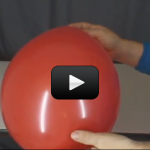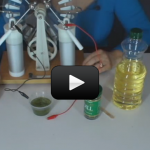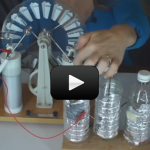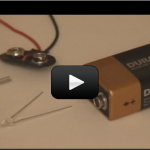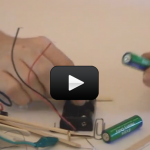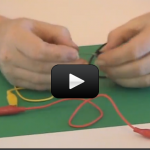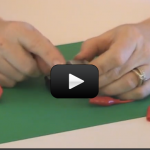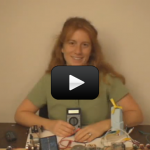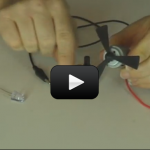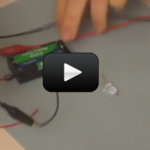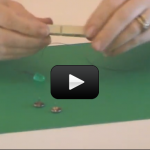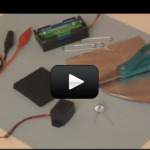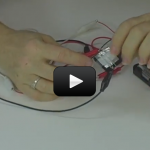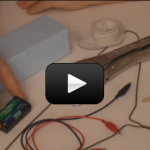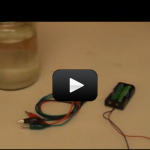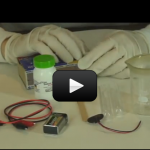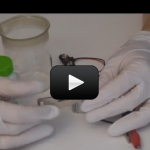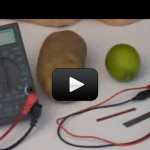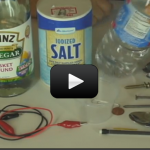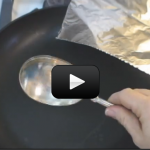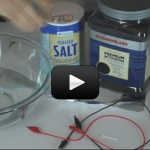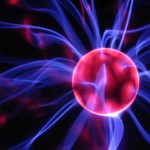Detecting the Electric Field
You are actually fairly familiar with electric fields too, but you may not know it. Have you ever rubbed your feet against the floor and then shocked your brother or sister? Have you ever zipped down a plastic slide and noticed that your hair is sticking straight up when you get to the bottom? Both … Continue reading "Detecting the Electric Field" |
Seeing Electric Fields Using Your Spice Rack
Have you wrapped your mind around static electricity yet? You should understand by now how scuffing along a carpet in socks builds up electrons, which eventually jump off in a flurry known as a spark. And you also probably know a bit about magnets and how magnets have north and south poles AND a magnetic … Continue reading "Seeing Electric Fields Using Your Spice Rack" |
Advanced Static Electricity Experiments
You can use the idea that like charges repel (like two electrons) and opposites attract to move stuff around, stick to walls, float, spin, and roll. Make sure you do this experiment first. I’ve got two different videos that use positive and negative charges to make things rotate, the first of which is more of … Continue reading "Advanced Static Electricity Experiments" |
Alien Detector (Advanced)
This simple FET circuit is really an electronic version of the electroscope. This “Alien Detector” is a super-sensitive static charge detector made from a few electronics parts. I originally made a few of these and placed them in soap boxes and nailed the lids shut and asked kids how they worked. (I did place a … Continue reading "Alien Detector (Advanced)" |
Cosmic Ray Detector
When high energy radiation strikes the Earth from space, it’s called cosmic rays. To be accurate, a cosmic ray is not like a ray of sunshine, but rather is a super-fast particle slinging through space. Think of throwing a grain of sand at a 100 mph… and that’s what we call a ‘cosmic ray’. |
Basic Circuits
An electrical circuit is like a NASCAR raceway. The electrons (racecars) zip around the race loop (wire circuit) superfast to make stuff happen. Although you can’t see the electrons zipping around the circuit, you can see the effects: lighting up LEDs, sounding buzzers, clicking relays, etc. There are many different electrical components that make the … Continue reading "Basic Circuits" |
Conductivity Testers
Make yourself a grab bag of fun things to test: copper pieces (nails or pipe pieces), zinc washers, pipe cleaners, Mylar, aluminum foil, pennies, nickels, keys, film canisters, paper clips, load stones (magnetic rock), other rocks, and just about anything else in the back of your desk drawer. Certain materials conduct electricity better than others. … Continue reading "Conductivity Testers" |
Wiring Up Motors
Imagine you have two magnets. Glue one magnet on an imaginary record player (or a ‘lazy susan’ turntable) and hold the other magnet in your hand. What happens when you bring your hand close to the turntable magnet and bring the north sides together? The magnet should repel and move, and since it’s on a … Continue reading "Wiring Up Motors" |
How to use a Digital MultiMeter
One of the most useful tools a scientist can have! A digital multimeter can quickly help you discover where the trouble is in your electrical circuits and eliminate the hassle of guesswork. When you have the right tool for the job, it makes your work a lot easier (think of trying to hammer nails with … Continue reading "How to use a Digital MultiMeter" |
Dimmers and Motor Speed Controllers
So now you know how to hook up a motor, and even wire it up to a switch so that it goes in forward and reverse. But what if you want to change speeds? This nifty electrical component will help you do just that. Once you understand how to use this potentiometer in a circuit, … Continue reading "Dimmers and Motor Speed Controllers" |
Electric Eye
This is a super-cool and ultra-simple circuit experiment that shows you how a CdS (cadmium sulfide cell) works. A CdS cell is a special kind of resistor called a photoresistor, which is sensitive to light. A resistor limits the amount of current (electricity) that flows through it, and since this one is light-sensitive, it will … Continue reading "Electric Eye" |
Trip Wire Burglar Alarm
Burglar alarms not only protect your stuff, they put the intruder into a panic while they attempt to disarm the triggered noisemaker. Our burglar alarms are basically switches which utilize the circuitry from Basic Circuits and clever tricks in conductivity. A complete and exhaustive description of electronics would jump into the physics of solid state … Continue reading "Trip Wire Burglar Alarm" |
Pressure Sensor Burglar Alarm
By controlling how and when a circuit is triggered, you can easily turn a simple circuit into a burglar alarm – something that alerts you when something happens. By sensing light, movement, weight, liquids, even electric fields, you can trigger LEDs to light and buzzers to sound. Your room will never be the same. Switches … Continue reading "Pressure Sensor Burglar Alarm" |
Latching Circuit
Once you’ve made the Pressure Sensor burglar alarm, you might be wondering how to make the alarm stay on after it has been triggered, the way the Trip Wire Sensor does. The reason this isn’t as simple as it seems is that the trip wire is a normally closed (NC) switch while the pressure sensor … Continue reading "Latching Circuit" |
Nerve Tester
Electrical circuits are used for all kinds of applications, from blenders to hair dryers to cars. And games! Here’s a quick and easy game using the principles of conductivity. This experiment is a test of your nerves and skill to see if you can complete the roller coaster circuit and make it from one end … Continue reading "Nerve Tester" |
Electrolytes
When an atom (like hydrogen) or molecule (like water) loses an electron (negative charge), it becomes an ion and takes on a positive charge. When an atom (or molecule) gains an electron, it becomes a negative ion. An electrolyte is any substance (like salt) that becomes a conductor of electricity when dissolved in a solvent … Continue reading "Electrolytes" |
Electrolysis
If you guessed that this has to do with electricity and chemistry, you’re right! But you might wonder how they work together. Back in 1800, William Nicholson and Johann Ritter were the first ones to split water into hydrogen and oxygen using electrolysis. |
Electroplating
If you don’t have equipment lying around for this experiment, wait until you complete Unit 10 (Electricity) and then come back to complete this experiment. It’s definitely worth it! Electroplating was first figured out by Michael Faraday. The copper dissolves and shoots over to the key and gets stuck as a thin layer onto the … Continue reading "Electroplating" |
Fruit Battery
This experiment shows how a battery works using electrochemistry. The copper electrons are chemically reacting with the lemon juice, which is a weak acid, to form copper ions (cathode, or positive electrode) and bubbles of hydrogen. These copper ions interact with the zinc electrode (negative electrode, or anode) to form zinc ions. The difference in … Continue reading "Fruit Battery" |
Salty Battery
Using ocean water (or make your own with salt and water), you can generate enough power to light up your LEDs, sound your buzzers, and turn a motor shaft. We’ll be testing out a number of different materials such as copper, aluminum, brass, iron, silver, zinc, and graphite to find out which works best for … Continue reading "Salty Battery" |
Silver Battery
Never polish your tarnished silver-plated silverware again! Instead, set up a ‘silverware carwash’ where you earn a nickel for every piece you clean. (Just don’t let grandma in on your little secret!) We’ll be using chemistry and electricity together (electrochemistry) to make a battery that reverses the chemical reaction that puts tarnish on grandma’s good … Continue reading "Silver Battery" |
Air Battery
It’s easy to use chemistry to generate electricity, once you understand the basics. With this experiment, you’ll use aluminum foil, salt, air, and a chemical from an aquarium to create an air battery. This experiment is for advanced students. |
Ten Static Electricity Experiments to Mystify Your Kids
The smallest thing around is the atom, which has three main parts – the core (nucleus) houses the protons and neutrons, and the electron zips around in a cloud around the nucleus. The proton has a positive charge, and the electron has a negative charge. In the hydrogen atom, which has one proton and one … Continue reading "Ten Static Electricity Experiments to Mystify Your Kids" |

